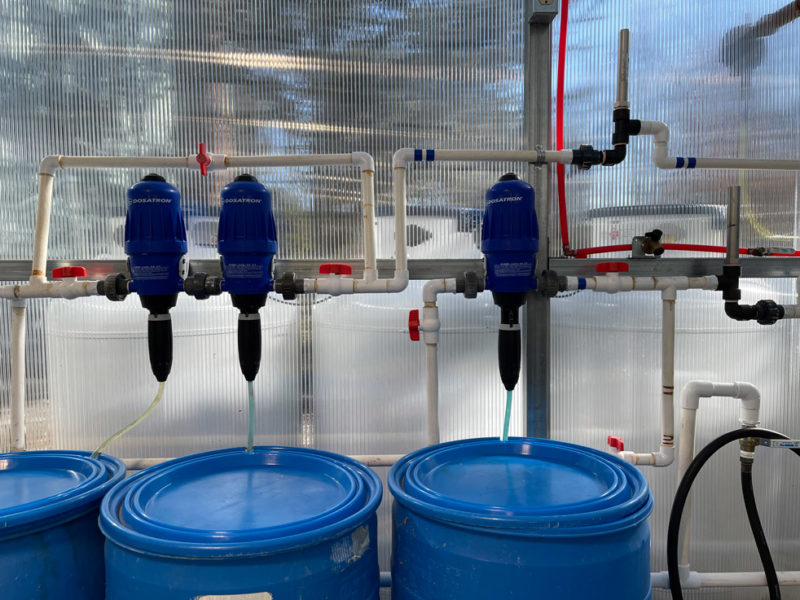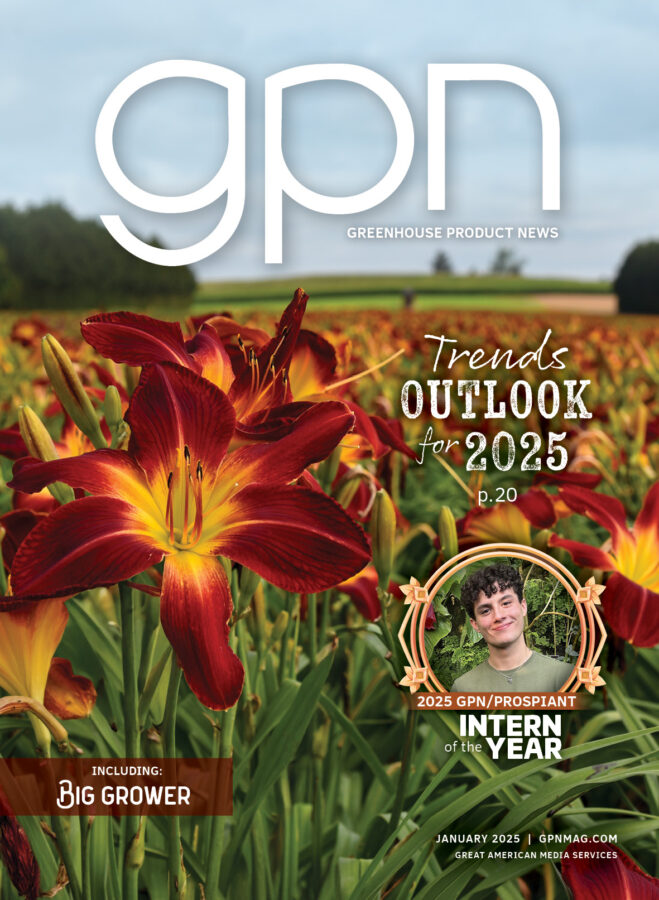Duets: Soluble Fertilizer Technology Continues to Advance
My guest today is Rick Vetanovetz, director of professional technical services at The Hawthorne Gardening Co. Rick has been in the horticulture industry since the 1970s, when he worked at a greenhouse-garden center. He earned an undergraduate degree in ornamental horticulture from Delaware Valley University and advanced degrees in horticulture from The Ohio State University. Rick has worked for various horticultural product companies and specializes in plant nutrition, soil biochemistry and soil/plant analysis. He resides in Henderson, Nevada, where he and his wife Shawnee try to grow plants in the desert.

Peter: Thanks for joining me, Rick. Let’s start with your response to the following statement: Our generation of growers, now in our 60s, benefited from research focused on putting all the nutrients into one bag of soluble fertilizer. This allowed us to use a single stock tank and injector system. Why are we leaving this philosophy behind and where is soluble fertilizer technology heading?
Rick: Wow, you could write books on that comment. When you think about the entry of high-quality water soluble fertilizers into horticulture, that was the time when the raw materials for fertilizers became more refined with better solubility. These components were ingredients such as urea, potassium nitrate, monoammonium phosphate, potassium chloride and magnesium sulfate.

When chelated micronutrients became available, more holistic, “one bag” solutions followed. But that was at a time when horticulture relied on soil- based systems that supplied sufficient calcium and magnesium to the plant for satisfactory growth. Remember the days when we mixed our 2:1:1 soil, peat and perlite mix with added dolomitic limestone and a nutrient charge? Then we had to pasteurize that stuff. Good times, but I have a point.
Also, the use of water-soluble fertilizers played well with the use of fertilizer injectors. That was a big deal. Really, THAT was the breakthrough — it meant you could make a concentrated fertilizer stock solution and the injector would dilute the fertilizer into the irrigation stream to a concentration right for the crop. Many flower growers got used to the one-bag deal.
Peter: That’s a great point, Rick. As a youngster, I have a vivid memory of watching my dad mix final-strength fertilizer in a 50-gallon drum with a submersible pump attached to a hose and then my mom would apply it directly to the geranium crop. This was before constant- feed days as well; the concentration was high and applied at two-week intervals.
Then he bought his first injector with the ratio of 1:128. I was in grade school at the time and he taught me how to prime it before each use so I could help out. Back then, the dye was added separately — it hadn’t yet become an ingredient in the bag of fertilizer. We used green dye and my hands would be green as grass whenever I mixed a stock tank. Then he upgraded to a battle-tested brass injector — I believe the brand was Smith with a 1:100 ratio. It also required priming, was reliable, and served our growing greenhouse operation through the ‘70s.
We upgraded to an Anderson in the 1980s. That unit had multiple-injector-head capability that served us well as we moved from single-bag fertilizer blends to multiple bag blends tailored to our crop requirements.

Rick: The thing is these fertilizers did not have calcium, mainly, and, to a lesser extent, magnesium, in the formula. That’s because you chemically cannot mix phosphorous and calcium together in a concentrated solution. And this became important with widespread use of soilless growing media and the importance of water quality in crafting a nutritional program.
What these factors did was place more importance on the supply of calcium and magnesium to crops as well as a vehicle for managing growing medium pH. I remember discussing that at a grower meeting in Massachusetts with you back in 1988!
So, what happened? Fertilizer technology moved forward to find ways to add calcium and magnesium into a one-bag presentation, keeping the one-bag system.
Peter: Your research and outreach helped lay the educational foundation for growers to advance beyond simply knowing the pH of their irrigation water and to understanding alkalinity as well. I often use the analogy of rungs of a ladder representing successive steps up a learning curve. Focusing on alkalinity was a BIG deal, too.
Rick: Certainly, you can have one stock solution containing a calcium-based fertilizer and another stock solution containing a phosphorous based solution and it would work just fine. In fact, I helped customers do that very thing, like a 15-0-15 with 20-10-20 or 15-11-29 plus magnesium. The one-bag system was the gold standard because we all thought that growers would not put up with multiple injectors. Point is, we never really thought having multiple inputs to allow the grower easy flexibility was something to strongly consider.
Gosh, with the cannabis/hemp industry coming to the forefront, cannabis growers consider whatever it takes to grow high-quality, super-premium product. So, if these growers need to add another injector or two, it does not matter — of course they’re going to do it. The payback (important point) is usually there. So, the one-bag paradigm went out the window.
Peter: Another driving force in growers accepting multiple injectors was the arrival of portable Dosatron injector technology. Self- priming, versatile, permanent or portable, and economical … this injector category makes it easy to justify multiple units around a greenhouse range. Figure 1 shows recently installed Dosatron units in my research greenhouse.
As you and our colleagues pushed forward with the research, I as a commercial grower chose to have a half dozen portable Dosatron units that I’d move from Quonset to Quonset, depending on whether I had a petunia crop requiring an acidic fertilizer or a seed geranium crop requiring a basic fertilizer. As a small grower, I was reassured that fertilizer and injector technology allowed me to specialize not in monoculture but many-culture.
Rick: Not to give cannabis growers too much credit, but you also had greenhouse growers injecting materials to adjust water quality or to add silicon, so ornamental crop growers got used to the idea of having multiple injectors anyway. Go back to the thought about convergence of technology and irrigation and fertilizer control — systems are now able to set fertilizer targets for crops and tailored crop recipes are getting easier and easier to deliver.
Peter: Recent industry consolidation has led us to more monoculture production. A large operation may still produce spring bedding species from A to Z; however, they have achieved scale, which allows entire greenhouse sections to be managed as monoculture production units. This allows for dedicated environment control, pest management and labor. It also allows for individualized crop nutrition management. How is the soluble fertilizer market integrating with this?
Rick: I really can’t say for sure how the fertilizer market is integrating into the trend per se. But I can tell you that if I was a grower who had an entire greenhouse of one or similar plant types, I’d have a system that delivered the right nutrients at the right time at the right amounts and ratios to drive growth and quality. I think the tools are out there but it just has to be in a system that growers can recognize and embrace. Other technologies like drip irrigation and control technologies will foster this movement.
With that being said, the fertilizer industry needs to package the components so that nutritional recipes can be easily varied and obtained with the know-how and instructions to help the grower understand and implement. I can tell you that at Hawthorne Gardening Co. we are doing just that. It’s really an exciting time, Peter. We are at a point where we have the technologies and tools to grow plants in a more controlled and sustainable way — at Hawthorne, we call that Hawthorne 360.
Peter: I observe this monoculture versus many-culture reality play out at different extremes of operational size. Plenty of ink is spent on following trends for large-scale horticulture, but how is soluble fertilizer use adapting to smaller size operations that will never achieve the operational scale described above?
Rick: Exactly. The challenge is when you are trying to grow a wide variety of plant types, sizes and forms, but it also depends on what you consider small. Even smaller operations can justify installing two or three injectors together to deliver a nutrient solution that is generally acceptable to a wide variety of plant types. Look at how you are using multiple injectors in your relatively small research greenhouse.
I realize this article is about water soluble fertilizers but when it comes to nutritional programs, it’s not always up to what is in the liquid fertilizer program. You can then use granularly applied controlled- release fertilizers to augment those plants that may need more nutrients such as large containers, perennials or hanging baskets. Advances in coating technologies have made this approach a great way to go.
Peter: That’s a great point to end on today; let’s return to discuss it in depth soon. Thanks for sharing your insight, Rick.


 Video Library
Video Library 



















